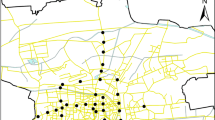Abstract
Concentrations and profiles of polycyclic aromatic hydrocarbons (PAHs) were determined in thirty dust samples collected from kitchens that use wood cook system (WCS), kerosene stove cook system (KSCS) and butane gas cook system (BGCS). The total PAHs concentrations ranged from 52 to 497, 39 to 96 and 37 to 155 μg kg−1 for WCS, KSCS and BGCS respectively. The results indicate predominance of lower molecular weight (2–3 rings) over higher molecular weight PAHs and users of wood cook system are more exposed to higher levels of PAHs than the users of either kerosene cook system or butane gas cook system.
Similar content being viewed by others
References
Ayoko GA, Morawska L, Kokot S, Gilbert D (2004) Application of multicriteria decision making methods to air quality in the microenvironments of residential house in Brisbane, Australia. Environ Sci Tech 38:2609–2616
Baran S, Oleszczuk P, Lesiuk A, Baranowska E (2002) Trace metals and polycyclic aromatic hydrocarbons in surface sediment samples from the Narew River (Poland). Polish J Environ Stud 14(4):299–305
Butte W (2003) Indoor environment. In: Morawska L, Salthammer T (eds) Airborne particles and settle dusts. Wiley, NY, p 434
Butte W (2004) Indoor air pollution. In: Pluschke P (ed) The handbook of environmental chemistry, vol 4. Verlag, Wisrsburg, p 116
Fernandes MB, Sicer MA, Bioreu A, Troczynska J (1997) Polyaromatic hydrocarbons (PAHs) distributions in the Siene River and its estuary. Marine Pollut Bull 34(11):857–867
Kabata-Pendias A, Piotrowska M, Motowicka-Trelak T, Maliszewska-Kordybach B, Filipiak K, Krakowiak A, Pietruch C (1995) Podstawyoceny chemicznego zainieczyszczenia glab. Metals ciezkie, siarka i WWA (introduction to evaluation of chemical contamination of soils. Heavy metals, sulphur and PAHs). Biblioteka monitoringu Srodowiska Warszawa (environmental monitoring library, Warsaw) (in polish)
Khalili NR, Scheff PA, Holsen TM (1995) PAHs source finger print for coke oven, diesel and gasoline engines, highway tunnels, and wood combustion emissions. Atmos Environ 29:533–542
King S, Meyer JS, Andrews ARJ (2002) Polycyclic aromatic hydrocarbons in soil using hollow fiber membrane solvent micro extraction. J Chrom A982:201–208
Marynowski L, Pieta M, Janeczek J (2004) Composition and source of polycyclic aromatic compounds in deposited dust from selected sites around the upper Silesia, Poland. Geol Quart 84(2):169–180
Ong S, Ayoko GA, Kokot S, Morawska L (2007) Polycyclic aromatic hydrocarbons in house dust samples: source identification and apportionment. In: Proceedings of the 14th international IUAPPA world congress, Brisbane, Australia
Pies C, Yang Y, Hotmann T (2007) Distribution of polycyclic aromatic hydrocarbons (PAHs) in flood plains soils of the mosel and saar river. J Soil Sediment. doi:10.1065/JSS.2007.06.233
Ravindra K, Sokhi R, Van Grineken R (2008) Atmospheric polycyclic aromatic hydrocarbons source attribution, emission factors and regulation. Atmos Environ. doi:10.1016/j.atmosenv.2007.12.010
Samimi SV, Akbari Rad R, Ghanizadeh F (2009) Polycyclic aromatic hydrocarbon contamination levels in collected samples from vicinity of highway. Iranian J Environ Health Sci Eng 6(1):47–52
Soclo HA, Garrigues P, Ewald M (2000) Origin of polycyclic aromatic hydrocarbon (PAHs) in coastal marine sediments. Case studies in Cotonou (Benin) and Aquitaine (France) areas. Marine Pollut Bull 40:387–396
Van Brummelen TC, Verweij RA, Wedzinga SA, van Gestel CAM (1996) Environment of polycyclic aromatic hydrocarbons in forest soil near a blast furnace plant. Chemosphere 32:293–314
Wilcke W, Amelung W, Krauss M, Martius C, Bandeira A, Garcia M (2003) Polycyclic aromatic hydrocarbons (PAHs) patterns in climatically different ecological zones of Brazil. Organic Geochem 34:1405–1417
Wilcke W, Krauss M, Safronov G, Fokin AD, Kaupenjohann M (2005) Concentration, temporal trend and small-scale distribution. J Environ Qual 31:1581–1590
Yu XZ, Gao YM, Wu SC, Zhang HG, Gheung KC, Wong MH (2006) Distribution of polycyclic aromatic hydrocarbons in soils at Guiya area of China, affected by recycling of electronic waste using primitive technologies. Chemosphere. doi:10.1016/j.chemosphere. 2006.04.006
Author information
Authors and Affiliations
Corresponding author
Rights and permissions
About this article
Cite this article
Iwegbue, C.M.A. Polycyclic Aromatic Hydrocarbons Profile of Kitchen Dusts. Bull Environ Contam Toxicol 86, 298–301 (2011). https://doi.org/10.1007/s00128-011-0213-3
Received:
Accepted:
Published:
Issue Date:
DOI: https://doi.org/10.1007/s00128-011-0213-3




